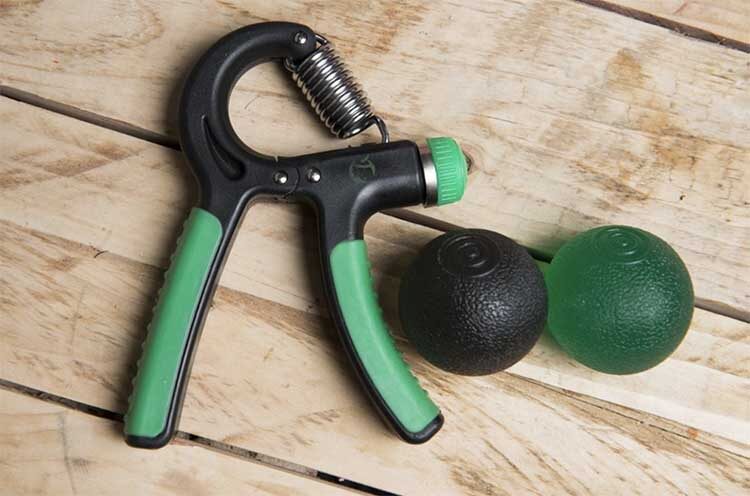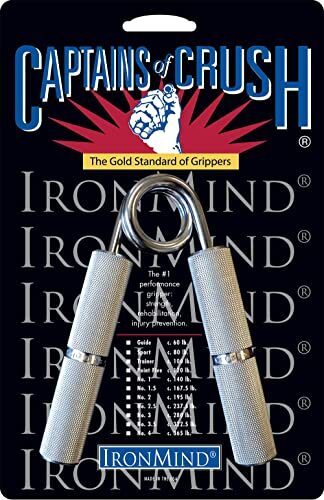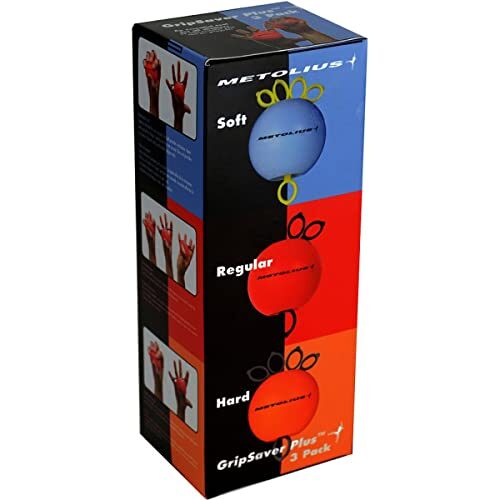Your cart is currently empty!
{ TOP 7 } Best Grip Strengthener – 2020 Reviews
Views: 0

While nothing builds climber strength quite like being on an actual climbing wall, this isn’t always an option. Sometimes your hands might need a break from the wall — grip strengtheners go a long way to help with conditioning and injury prevention. Sometimes a wall isn’t as accessible as you would hope and a trip to the crag or a gym only comes every once in a while. Sometimes extended travel threatens to negatively impact your climbing progress.
Hangboards are the next best option — but if even those types of training tools aren’t accessible or available, another option exists. There are relatively inexpensive, effective tools you can use to strengthen your grip strength, condition for endurance climbing, and prevent injury — even without touching the wall or a hangboard. There are a lot of ineffective tools out there — here are some tips for buying the best grip strengthener.
How do grip strengtheners really benefit your climbing? Any rock climber will tell you that no tool out there can perfectly replicate the muscle movements your hands and forearms make on the wall — there’s a lot more to climbing than just the squeeze movement that grip strengtheners provide. But grip strengtheners still have a lot to offer to rock climbing strength in terms of endurance, conditioning, and injury prevention. For example, rock climbing almost exclusively activates the flexor tendons in your forearm — the muscle used for gripping. On the flip side, rock climbing almost entirely neglects forearm extensors. Any active individual knows the dangers of over-utilizing one range of muscles or tendons without properly activating the opposite as well. This is where grip strengtheners come in — there are tools available that help you exercise your forearm extensors to counter the strain that climbing puts on the flexor tendons. This significantly helps with injury prevention. Then, there’s the main goal — strength. These tools will help strengthen your grip, increase muscle, tendon, and bone strength, correct muscular imbalances, increase blood flow, and increase flexibility and stability in your hands and forearms.
And, of course, the benefits of strength training for your grip go beyond the rock climbing world. Using grip strengtheners can help to prevent injuries including carpal tunnel and bicep tendonitis and increase strength needed to do all sorts of heavy lifting necessary in day to day life.
Several different types of grip strengtheners exist — but regardless of which style you decide best fit your needs, grip strengtheners are relatively straightforward to use. Workouts can be as simple as squeeze and release and extend and release (depending on which type of grip strengthener you’re using). Do warm-up sets by squeezing or extending ten times. Then, squeeze or extend for ten seconds ten times for one set. Complete as many sets as you can without straining the tendons or muscles. As you continue to use grip strengtheners, you’ll find you are able to complete more and more sets. For as inaccessible as climbing walls can be, these tools are extremely accessible and convenient. Use them on public transportation, during office meetings, or on the couch to build climbing strength even when you’re far from the climbing world.
As with all exercise, listening to your body is vital. Pay attention to where and how your muscles and tendons hurt. While grip strengtheners can be hugely beneficial for injury prevention, they can also lead to injury if you don’t use them correctly — as with all exercises.
One of the most important factors when using grip strengtheners is picking the correct resistance for your abilities and needs. Many grip strengtheners use 50 pounds as the beginner resistance. If you’re already a relatively strong rock climber (which you should be before aggressively training with grip strengtheners — beginner climbers should work to develop skill and technique before focusing more heavily on grip strength), your “beginner resistance” may be higher than 50 pounds. But, again, make sure you’re not over-exerting by choosing too heavy of a beginning weight. A lot of grip strengthening products offer ways to increase or decrease resistance — do so. Grip strengtheners that work extensor forearm muscles are great to use between climbing sessions — this will balance out all the strain you put on the primary forearm muscles that are used for climbing. Since climbing really stresses each finger individually, grip strengtheners are also helpful between workouts to balance out the capabilities of various fingers. If you work a lot of pocket problems, your middle fingers may be strained more frequently and more intensely than some of your exterior fingers. Grip strengtheners can help to balance this out.
As with all exercise, consistency is key. Using a grip strengthener once every month when you remember or have to take a long break off of climbing won’t result in significant grip strength gains. Try to be as regimented with grip strengthener tools as you are with the rest of your climbing habits.
There are two key factors to consider when choosing which grip strengthener best fits your needs — type of tool and resistance level variation capabilities. There are many different types of grip strengthening tools. Some tools work with a squeeze motion while others require that you extend your fingers — as discussed, these movements work two different sets of muscles and serve two different purposes for climbing training. Consider which one would benefit your climbing needs most. There are also different tools that have the ability to exercise one finger at a time versus an entire hand squeeze. Again, as we’ve discussed, this serves to either focus on weaker fingers or balance out the abilities of each finger. Each type of grip strengthener really serves a different purpose — consider where your weaknesses are and which tool would serve your needs best.
The other important factor to consider is whether the tool offers variable resistance functions — can you change the resistance level of the tool? Do you need to for what you’re hoping to train? For some tools, it’s very important that you’re able to change the resistance level in order to most effectively train and also avoid injury. For other tools, its effectiveness lies in its simplicity — and your hand will adjust to its resistance level.

IronMind has been producing hand grippers since 1988 and holds a spot as the industry leader. This burly aluminum alloy tool will definitely remind you of a weight room. The simple design combined with its production materials mean this tool is extremely durable — toss it in a briefcase, suitcase, or backpack and go. And if you still can’t really figure out how to best use the tool as effectively as possible, IronMind includes a downloadable training guide. While these aren’t great for training individual fingers, they’re extremely effective at increasing hand strength.
This tool’s resistance comes from a coil — and it’s fixed variable resistance. If you want to up your resistance or back it off a little, you’ll have to buy a second, third, fourth, fifth gripper — which has the potential to get pricey. But they certainly have a resistance level for just about everyone — from 60 pounds to 365 pounds. Some users also said that those with smaller hands had a harder time using this tool. They were forced to grip the handles further up which sacrificed leverage and comfort.
- Type: Whole Hand Grip
- Resistance: 11 difference fixed resistance levels
- Material: Aluminum Alloy
- Burly, simple, durable
- Downloadable training guide included
- Non-variable resistance levels
- Potentially pricey for a wide range of resistance levels
- Slightly less ideal for small-fingered users

As the brand name might suggest, whereas other grip strengtheners are designed for weight lifters or general strength building, the Metolius Gripsaver was designed specifically for climbers. This tool is unique in its ability to work both your grip strength and your extendor strength — squeeze the resistance ball for a grip workout and slip your fingers into the loops to extend. This design truly encourages exactly what climbers need most — a balance between the muscles they over-exert and the ones they barely use at all to climb. The design also allows climbers to extend individuals fingers at a time to work specific weaknesses.
You can get a 3-pack of Metolius Gripsavers at various levels of resistance. Climbers offered that the lowest level gripsaver — the blue one — was virtually useless for anyone who already climbs. But the additional two strengths are sufficient for an in-between climbs workout. Unfortunately, any resistance strengths outside of these three levels isn’t available — so this tool is still more or less a fixed resistance option which might be something to consider if you’re more interested in scaling up or scaling down strength training.
- Type: Whole Hand Grip/Individual Finger Extendor
- Resistance: 3 fixed variable options for purchase
- Material: Rubber, synthetic
- Three different resistance levels
- Specifically designed for climbers
- Offers options to exercise both grip strength and extension strength
- One of the more complex designs, less durable

This uniquely designed tool has more or less cornered the market on strength training for individual fingers. Designed for musicians — seven coils separated out with three layers of plastic allow you to press down on one lever at a time, all levers at once, or any combination in between. The Gripmaster’s lowest resistance level is 1.5 pounds per finger which is more than accessible for any climber. This tool is one of the smaller options — it would easily fit in a pocket or purse.
Much like some of the other grip strengtheners, the Gripmaster Hand Exerciser has a fixed resistance level — but several different options are available for purchase. And, as one of the cheaper options, purchasing several different resistance levels won’t break the bank. Options include the XX-Light, the X-Light, Light, Medium, and Heavy. Pro and regular options are available. The main difference between the two is size — the pro has a larger range of motion and larger finger pads. The Gripmaster Hand Exerciser also has one of the more complex designs with more moving parts — meaning there are more parts that could break. Some users have also complained that older models were better padded, and the newer models can get uncomfortable after long periods of use.
- Type: Individual Finger Grip
- Resistance: 5 fixed variable options for purchase
- Material: Plastic
- Inexpensive
- Uniquely offers strength training for individual fingers
- Small enough to fit in a pocket or purse
- Less durable with more moving parts
- Lack padding

While the finger stretcher is almost certainly one of the least sophisticated of the hand strengtheners, its benefits and effectiveness are just as certain. To use this tool, slip your fingers in the loops, extend slowly as you count to three, hold your fingers at their maximum extension point for one second, and release as you count to three. These little, rubber tools easily attach to keychains, gear loops, carabiners, etc. so it’s easy enough to always have one with you for the quick extendor workout between meetings, on public transit, or anywhere else.
Three resistance levels are available from 30 pounds of resistance to 50 pounds to address whatever level of forearm imbalance you’re feeling. You can also stack them together to increase resistance levels if your fingers can safely handle the pounds. These finger stretchers also help address problems like carpal tunnel, tendonitis, and tennis elbow. Be careful which finger stretcher product you purchase. Quite a few of these rubber finger stretchers are out there on the market — a lot of them break easily. Climbers have confirmed that these specific finger stretchers made by 5BILLION hold up to plenty of extensions — even though these are also the cheapest of all the tools we reviewed.
- Type: Whole Hand Extension
- Resistance: 3 fixed levels
- Material: Rubber
- Highly transportable
- Inexpensive
- Only 3 resistance levels available
- Doesn’t allow for individual finger extension
- Essentially the same tool as the Metolius Gripsaver without added benefit of grip training

While these are essentially glorified stress balls, the Friendly Swede Hand Grip is extremely well-rated on Amazon and by climbers alike. These thermoplastic rubber, egg-shaped balls come in three resistance levels — 20 pound, 30 pound, and 50 pound. While that lowest resistance level may sound rather low compared to what we know climbers are capable of gripping, it still serves to increase flexibility, alleviating pain, and preventing tension. In fact, while these tools do less for grip strength, they do wonders for hand tension. Like finger stretchers, these tools are easy to transport — but whereas finger stretchers can easily attach to keychains, these little grips get lost relatively easily. These tools also essentially serve the same purpose as the Metolius Gripmaster — without the added benefit of extendor training or being designed specifically for rock climbers.
The bright colors, low resistance levels, and egg shape also make these tools great for brand new, younger climbers. Want your child to get into the family business? Friendly Swede Hand Grips are the perfect introductory grip strengthening tool.
- Type: Whole Hand Grip
- Resistance: 3 fixed resistance levels
- Material: Skin-safe thermoplastic rubber
- Easy to transport
- Great for tension relief
- Essentially the same tool as the Metolius Gripsaver without the added benefit of extendor training
- Easy to lose
- Low resistance levels

Out of all the grip strengthening tools, this style is one of the best grip strengtheners for varying resistance levels. The NIYIKOW Grip Strengthening offers a tool that can range anywhere from 22 pounds of resistance to 132 pounds. While the maximum resistance of 132 is lower than the maximum resistance that most climbers can comfortably train with, this tool is a great starting point for anyone looking to build some serious grip strength in the future. 132 pounds of resistance is nothing to scoff at, after all. The solid steel coils that provide the resistance levels are extremely durable meaning the tool itself is as well.
The NIYIKOW Grip Strengthener is also, far and away, the most expensive of the grip strengtheners we examined. And, while it does boast an impressive resistance range, it might still be just the first of several tools an experienced climber chooses to purchase to train grip strength — an expense that might add up fairly quickly.
- Type: Whole Hand Grip
- Resistance: Variable from 22 to 132 pounds
- Material: Rubber, solid steel coils
- Easily vary resistance levels for training
- Extremely durable
- Expensive
- Maximum resistance level far below average maximum climber capabilities

Are you the type of person that tracks whatever you can using apps and high-tech gadgets? FitBit? Apple Watch? Garmin? The Sguegg Digital Hand Dynamometer is the high-tech equivalent of those apps and gadgets — for grip strength training. The Sguegg measures your grip strength in real-time using a dynamometer and uploads it to an app on Android and iOS. The app keeps track of your daily strength exercises, prompts you with daily challenges to increase grip strength, and lets you compete against fellow climbers who also have a Sguegg.
The bluetooth tool recharges in two hours, and then holds that charge for 80 hours. However, this is obviously one more thing you’ll have to keep in mind with the Sguegg — you’ll never need to charge a finger stretcher or any of the other grip tools. If you know you’re the type of person who needs to see data, real-time stats, and the opportunity for competition with fellow climbers, the sguegg might be the fun grip strength trainer for you.
- Type: Whole Hand Grip
- Resistance: Fixed
- Material: Silicone Exterior
- High tech strength tracking
- Requires charging
- Measures grip strength more than it works to increase it
In a lot of ways, training on the wall is just as important as how you train off the wall. Exercising opposing muscles in between sessions, relieving hand tension, and staying consistent are all problems that grip strengtheners can solve. While every climber is different and the needs of every climber vary in the same way, this guide has all the information you need to pick the best grip strengthening tool for your needs.

Elizabeth is a military public affairs journalist who enjoys nothing more than reading, researching, and writing — except, of course, rock climbing.